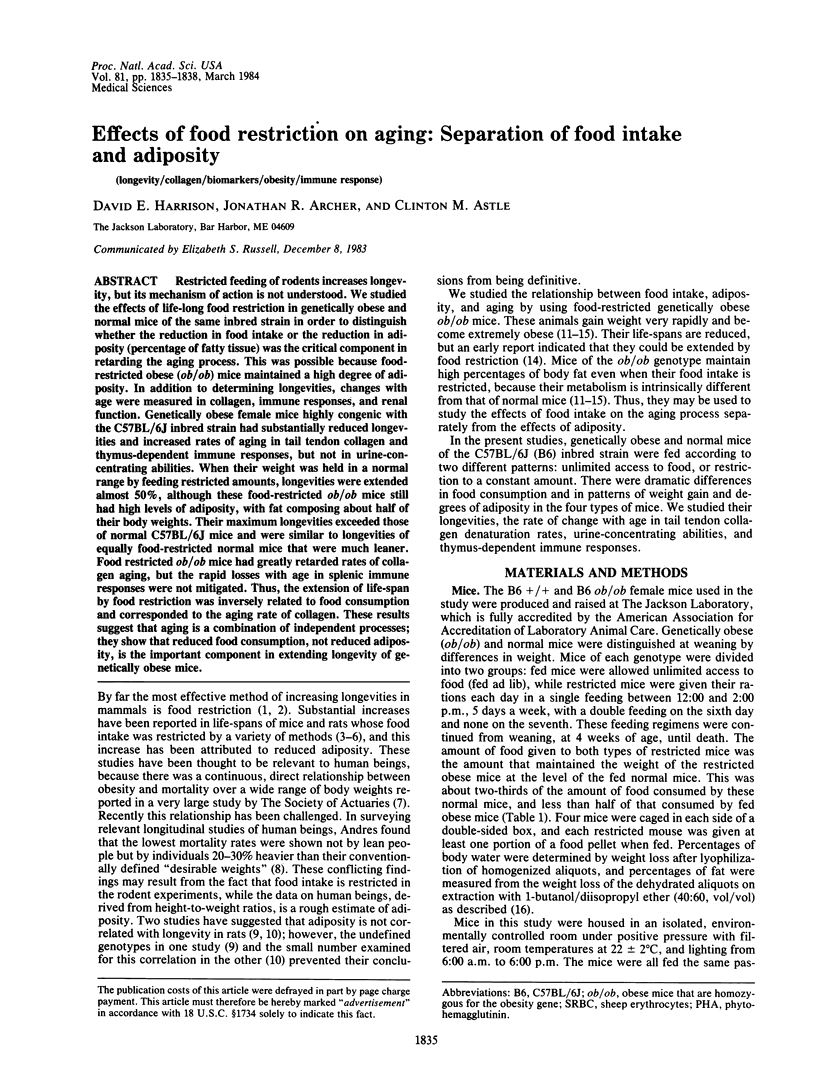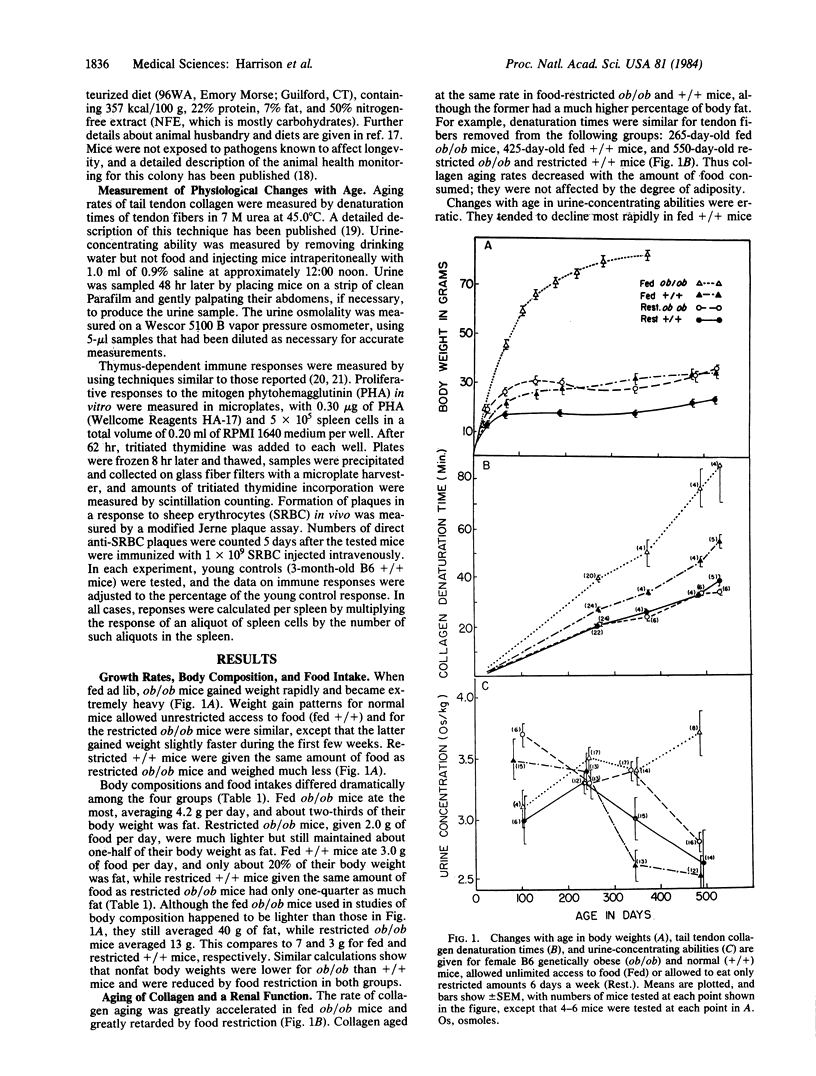Abstract
Restricted feeding of rodents increases longevity, but its mechanism of action is not understood. We studied the effects of life-long food restriction in genetically obese and normal mice of the same inbred strain in order to distinguish whether the reduction in food intake or the reduction in adiposity (percentage of fatty tissue) was the critical component in retarding the aging process. This was possible because food-restricted obese (ob/ob) mice maintained a high degree of adiposity. In addition to determining longevities, changes with age were measured in collagen, immune responses, and renal function. Genetically obese female mice highly congenic with the C57BL/6J inbred strain had substantially reduced longevities and increased rates of aging in tail tendon collagen and thymus-dependent immune responses, but not in urine-concentrating abilities. When their weight was held in a normal range by feeding restricted amounts, longevities were extended almost 50%, although these food-restricted ob/ob mice still had high levels of adiposity, with fat composing about half of their body weights. Their maximum longevities exceeded those of normal C57BL/6J mice and were similar to longevities of equally food-restricted normal mice that were much leaner. Food restricted ob/ob mice had greatly retarded rates of collagen aging, but the rapid losses with age in splenic immune responses were not mitigated. Thus, the extension of life-span by food restriction was inversely related to food consumption and corresponded to the aging rate of collagen. These results suggest that aging is a combination of independent processes; they show that reduced food consumption, not reduced adiposity, is the important component in extending longevity of genetically obese mice.
Full text
PDF



Selected References
These references are in PubMed. This may not be the complete list of references from this article.
- ALONSO L. G., MAREN T. H. Effect of food restriction on body composition of hereditary obese mice. Am J Physiol. 1955 Nov;183(2):284–290. doi: 10.1152/ajplegacy.1955.183.2.284. [DOI] [PubMed] [Google Scholar]
- Andres R. Influence of obesity on longevity in the aged. Adv Pathobiol. 1980;7:238–246. [PubMed] [Google Scholar]
- Astle C. M., Harrison D. E. Effects of marrow donor and recipient age on immune responses. J Immunol. 1984 Feb;132(2):673–677. [PubMed] [Google Scholar]
- Bengele H. H., Mathias R. S., Perkins J. H., Alexander E. A. Urinary concentrating defect in the aged rat. Am J Physiol. 1981 Feb;240(2):F147–F150. doi: 10.1152/ajprenal.1981.240.2.F147. [DOI] [PubMed] [Google Scholar]
- Bertrand H. A., Lynd F. T., Masoro E. J., Yu B. P. Changes in adipose mass and cellularity through the adult life of rats fed ad libitum or a life-prolonging restricted diet. J Gerontol. 1980 Nov;35(6):827–835. doi: 10.1093/geronj/35.6.827. [DOI] [PubMed] [Google Scholar]
- Burich R. L. Effects of age on renal function and enzyme activity in male C57BL/6 mice. J Gerontol. 1975 Sep;30(5):539–545. doi: 10.1093/geronj/30.5.539. [DOI] [PubMed] [Google Scholar]
- CHVAPIL M., HRUZA Z. The influence of aging and undernutrition on chemical contractility and relaxation of collagen fibres in rats. Gerontologia. 1959;3:241–252. doi: 10.1159/000210903. [DOI] [PubMed] [Google Scholar]
- Coleman D. L. Obese and diabetes: two mutant genes causing diabetes-obesity syndromes in mice. Diabetologia. 1978 Mar;14(3):141–148. doi: 10.1007/BF00429772. [DOI] [PubMed] [Google Scholar]
- Everitt A. V. Food intake, growth and the ageing of collagen in rat tail tendon. Gerontologia. 1971;17(2):98–104. doi: 10.1159/000211812. [DOI] [PubMed] [Google Scholar]
- Fernandes G., Friend P., Yunis E. J., Good R. A. Influence of dietary restriction on immunologic function and renal disease in (NZB x NZW) F1 mice. Proc Natl Acad Sci U S A. 1978 Mar;75(3):1500–1504. doi: 10.1073/pnas.75.3.1500. [DOI] [PMC free article] [PubMed] [Google Scholar]
- Fernandes G., Yunis E. J., Good R. A. Influence of diet on survival of mice. Proc Natl Acad Sci U S A. 1976 Apr;73(4):1279–1283. doi: 10.1073/pnas.73.4.1279. [DOI] [PMC free article] [PubMed] [Google Scholar]
- Giles J. S., Everitt A. V. The role of the thyroid and food intake in the ageing of collagen fibres. I. In the young rat. Gerontologia. 1967;13(2):65–69. doi: 10.1159/000211581. [DOI] [PubMed] [Google Scholar]
- Golub L. M., Greenwald R. A., Zebrowski E. J., Ramamurthy N. S. The effect of experimental diabetes on the molecular characteristics of soluble rat-tail tendon collagen. Biochim Biophys Acta. 1978 May 24;534(1):73–81. doi: 10.1016/0005-2795(78)90477-4. [DOI] [PubMed] [Google Scholar]
- Goodrick C. L. Body weight change over the life span and longevity for C57BL/6J mice and mutations which differ in maximal body weight. Gerontology. 1977;23(6):405–413. doi: 10.1159/000212216. [DOI] [PubMed] [Google Scholar]
- Goodrick C. L. Body weight increment and length of life: the effect of genetic constitution and dietary protein. J Gerontol. 1978 Mar;33(2):184–190. doi: 10.1093/geronj/33.2.184. [DOI] [PubMed] [Google Scholar]
- Gregory J. G., Barrows C. H. The effect of age on renal functions of female rats. J Gerontol. 1969 Jul;24(3):321–323. doi: 10.1093/geronj/24.3.321. [DOI] [PubMed] [Google Scholar]
- Gärtner K. Glomerular hyperfiltration during the onset of diabetes mellitus in two strains of diabetic mice (c57bl/6j db/db and c57bl/ksj db/db). Diabetologia. 1978 Jul;15(1):59–63. doi: 10.1007/BF01219330. [DOI] [PubMed] [Google Scholar]
- Hackbarth H., Harrison D. E. Changes with age in renal function and morphology in C57BL/6, CBA/HT6, and B6CBAF1 mice. J Gerontol. 1982 Sep;37(5):540–547. doi: 10.1093/geronj/37.5.540. [DOI] [PubMed] [Google Scholar]
- Hamlin C. R., Kohn R. R., Luschin J. H. Apparent accelerated aging of human collagen in diabetes mellitus. Diabetes. 1975 Oct;24(10):902–904. doi: 10.2337/diab.24.10.902. [DOI] [PubMed] [Google Scholar]
- Harrison D. E., Archer J. R., Astle C. M. The effect of hypophysectomy on thymic aging in mice. J Immunol. 1982 Dec;129(6):2673–2677. [PubMed] [Google Scholar]
- Harrison D. E., Archer J. R. Measurement of changes in mouse tail collagen with age: temperature dependence and procedural details. Exp Gerontol. 1978;13(1-2):75–82. doi: 10.1016/0531-5565(78)90033-5. [DOI] [PubMed] [Google Scholar]
- Harrison D. E., Archer J. R. Physiological assays for biological age in mice: relationship of collagen, renal function, and longevity. Exp Aging Res. 1983 Winter;9(4):245–251. doi: 10.1080/03610738308258459. [DOI] [PubMed] [Google Scholar]
- Harrison D. E., Archer J. R., Sacher G. A., Boyce F. M., 3rd Tail collagen aging in mice of thirteen different genotypes and two species: relationship to biological age. Exp Gerontol. 1978;13(1-2):63–73. doi: 10.1016/0531-5565(78)90032-3. [DOI] [PubMed] [Google Scholar]
- Kay M. M. An overview of immune aging. Mech Ageing Dev. 1979 Jan;9(1-2):39–59. doi: 10.1016/0047-6374(79)90119-2. [DOI] [PubMed] [Google Scholar]
- LANE P. W., DICKIE M. M. The effect of restricted food intake on the life span of genetically obese mice. J Nutr. 1958 Apr 10;64(4):549–554. doi: 10.1093/jn/64.4.549. [DOI] [PubMed] [Google Scholar]
- Lesser G. T., Deutsch S., Markofsky J. Aging in the rat: longitudinal and cross-sectional studies of body composition. Am J Physiol. 1973 Dec;225(6):1472–1478. doi: 10.1152/ajplegacy.1973.225.6.1472. [DOI] [PubMed] [Google Scholar]
- Leto S., Kokkonen G. C., Barrows C. H. Dietary protein life-span, and physiological variables in female mice. J Gerontol. 1976 Mar;31(2):149–154. doi: 10.1093/geronj/31.2.149. [DOI] [PubMed] [Google Scholar]
- Leto S., Kokkonen G. C., Barrows C. H., Jr Dietary protein, life-span, and biochemical variables in female mice. J Gerontol. 1976 Mar;31(2):144–148. doi: 10.1093/geronj/31.2.144. [DOI] [PubMed] [Google Scholar]
- Levin P., Janda J. K., Joseph J. A., Ingram D. K., Roth G. S. Dietary restriction retards the age-associated loss of rat striatal dopaminergic receptors. Science. 1981 Oct 30;214(4520):561–562. doi: 10.1126/science.7291993. [DOI] [PubMed] [Google Scholar]
- Masoro E. J., Yu B. P., Bertrand H. A., Lynd F. T. Nutritional probe of the aging process. Fed Proc. 1980 Dec;39(14):3178–3182. [PubMed] [Google Scholar]
- Meade C. J., Brandon D. R., Smith W., Simmonds R. G., Harris S., Sowter C. The relationship between hyperglycaemia and renal immune complex deposition in mice with inherited diabetes. Clin Exp Immunol. 1981 Jan;43(1):109–120. [PMC free article] [PubMed] [Google Scholar]
- Meredith P. J., Walford R. L. Autoimmunity, histocompatibility, and aging. Mech Ageing Dev. 1979 Jan;9(1-2):61–77. doi: 10.1016/0047-6374(79)90120-9. [DOI] [PubMed] [Google Scholar]
- Ross M. H. Nutrition and longevity in experimental animals. Curr Concepts Nutr. 1976;4:43–57. [PubMed] [Google Scholar]
- Tuig J. G., Romsos D. R., Leveille G. A. Maintenance energy requirements and energy retention of young obese (ob/ob) and lean mice housed at 33 degrees and fed a high-carbohydrate or a high-fat diet. J Nutr. 1980 Jan;110(1):35–41. doi: 10.1093/jn/110.1.35. [DOI] [PubMed] [Google Scholar]
- Walford R. L., Liu R. K., Gerbase-Delima M., Mathies M., Smith G. S. Longterm dietary restriction and immune function in mice: response to sheep red blood cells and to mitogenic agents. Mech Ageing Dev. 1973 Dec;2(6):447–454. doi: 10.1016/0047-6374(73)90035-3. [DOI] [PubMed] [Google Scholar]
- Weindruch R. H., Kristie J. A., Cheney K. E., Walford R. L. Influence of controlled dietary restriction on immunologic function and aging. Fed Proc. 1979 May;38(6):2007–2016. [PubMed] [Google Scholar]
- Weindruch R., Walford R. L. Dietary restriction in mice beginning at 1 year of age: effect on life-span and spontaneous cancer incidence. Science. 1982 Mar 12;215(4538):1415–1418. doi: 10.1126/science.7063854. [DOI] [PubMed] [Google Scholar]
- Westman S. Development of the obese-hyperglycaemic syndrome in mice. Diabetologia. 1968 Jun;4(3):141–149. doi: 10.1007/BF01219435. [DOI] [PubMed] [Google Scholar]
- Yu B. P., Masoro E. J., Murata I., Bertrand H. A., Lynd F. T. Life span study of SPF Fischer 344 male rats fed ad libitum or restricted diets: longevity, growth, lean body mass and disease. J Gerontol. 1982 Mar;37(2):130–141. doi: 10.1093/geronj/37.2.130. [DOI] [PubMed] [Google Scholar]


